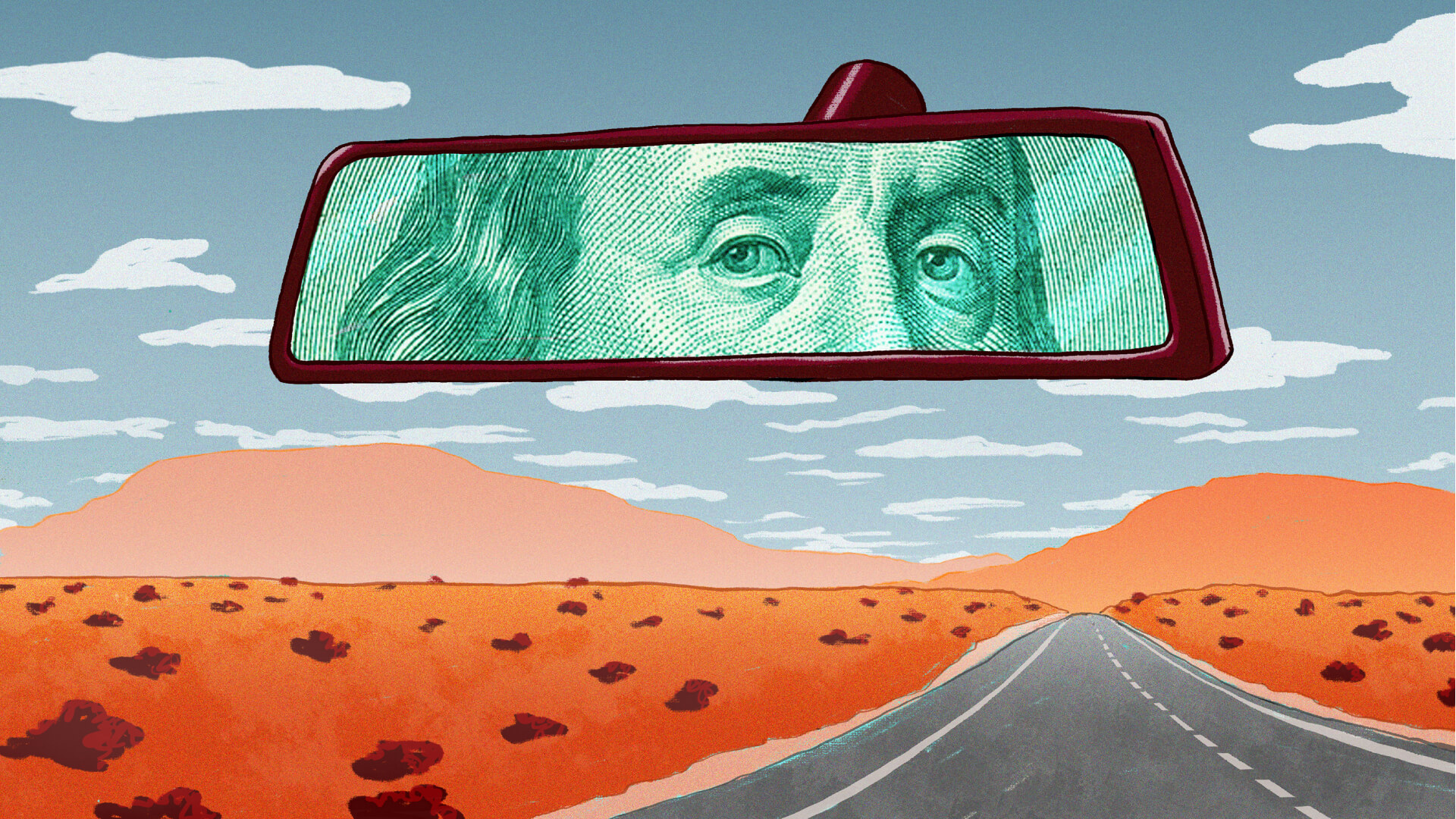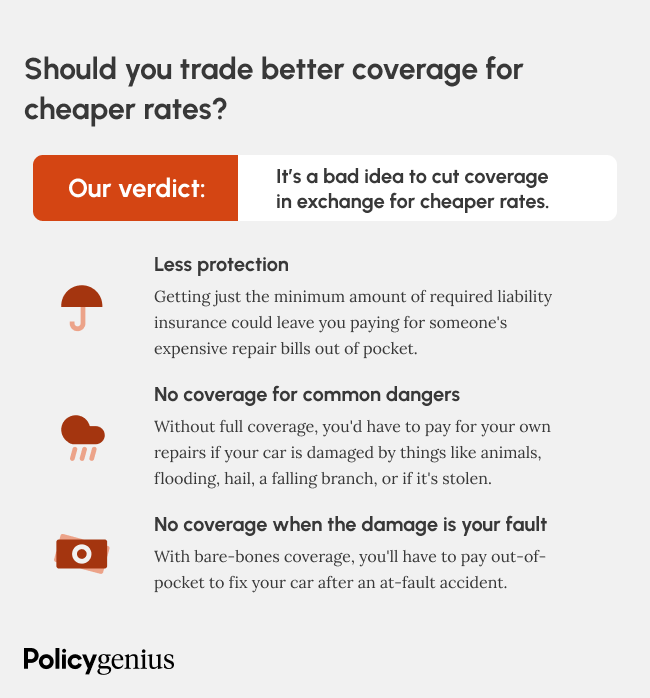Getting an auto insurance estimate is an easy way to make sure you don’t pay more than you have to for coverage. Lots of factors affect what you pay for car insurance you get, including your location, age, driving history, and more.
Policygenius has saved drivers an average of $435 per year on their car insurance after they compare rates. Our free car insurance calculator makes it easy to see what you'll pay for coverage.
How to get accurate car insurance coverage estimates
To get an accurate car insurance estimate from our calculator, make sure to take these steps:
1. Understand your coverage options
A car insurance policy is made up of different types of coverage that offer different types of protection. Depending on where you live, some may be required while others are always optional.
Bodily injury liability coverage (BIL): Pays for injuries to the other driver or their passengers if you’re responsible for an accident.
Property damage liability coverage (PDL): Covers damage to the other driver’s car after an at-fault accident. Also covers other property damage you’re responsible for, like if you crash into someone’s fence.
Uninsured or underinsured motorist protection (UI/UM): Pays for your own injuries or property damage if you’re hit by a driver without insurance (or without enough insurance to cover the accident).
Comprehensive coverage: Covers the cost of damage not caused by a car accident, like damage from extreme weather, falling objects, theft, vandalism, or animals.
Collision coverage: Covers damage to your own car after an at-fault accident.
Personal injury protection (PIP): Pays for your own medical expenses after an accident, regardless of who was at-fault (PIP is required in no-fault states).
These types of car insurance coverage typically make up what’s called a full-coverage policy, but there are other coverage add-ons you may want to consider, including roadside assistance, new car replacement, and rental car reimbursement coverage.
When you use an auto insurance calculator, you'll also have to choose a deductible amount for certain types of coverage, like comprehensive and collision. A car insurance deductible is the amount you'll need to pay out of pocket per-claim. Setting a higher deductible means lower rates, but it also means you'll need to foot more of the bill yourself if you ever actually need to use your coverage.
→ Read more about what types of coverage a regular insurance policy includes
2. Set a budget and understand rates
A car insurance premium is just the name for your regular car insurance payment. The more coverage you buy, the more expensive your car insurance will be.
For example, if you only buy enough insurance to meet your state's minimum requirements, the car insurance estimate you get may be an average of 66% (or $1,184 per year) lower than a full-coverage policy that includes comprehensive and collision protection.
We recommend getting as much liability coverage as you can afford, along with comprehensive and collision coverage. While getting full coverage means your rates will be higher, it's the best way to avoid paying for expensive medical bills and property damage out of pocket after a serious car accident.
Set an amount you’re comfortable paying per month or per year and get multiple car insurance estimates to find the company that offers you the most coverage at the cheapest rates.
3. Calculate how much car insurance you need
You need at least as much car insurance coverage as the law in your state requires — but what else do you need in a policy?
Most drivers need what’s called full-coverage car insurance, which is a policy that includes comprehensive and collision coverage. We also recommend getting a car insurance estimate for as much liability coverage as you can afford.
A solid full-coverage car insurance policy might look like:
Bodily injury liability coverage: $100,00 per person, $300,000 per accident
Property damage liability coverage: $100,000 per accident
Uninsured/underinsured motorist coverage: $100,000 per person, $300,000 per accident
Comprehensive: $500 deductible
Collision: $500 deductible
If you live in a no-fault state, you’ll also be required to get personal injury protection (PIP), which pays for your medical bills after an accident.
A typical full-coverage policy at our recommended limits costs $1,827 a year. But there are other add-ons that can raise your rates, so set your budget a little higher if you want things like roadside assistance, gap insurance, or new car replacement coverage.
→ Learn more about how much car insurance you need
4. Get estimates from multiple companies
Once you have an idea of how much coverage you need and what you can afford to pay for car insurance, you can get estimates for rates in your area. To get the best insurance rates from a car insurance calculator, you should know your:
Address, including city and state
Birthdates for every driver in your household
Driver's license numbers
Social Security numbers
The make, model, and VIN for every vehicle you want on the policy
Your current coverage limits (if you already have car insurance)
Remember to be honest when using an auto insurance calculator — if you fudge any details to get a lower rate (like omitting a recent accident or not including your teenage driver), you won't get an accurate estimate.
It's also a good idea to research the insurance companies with the lowest rates to make sure they don't have poor customer service or limited coverage options. When you've found the best company for your needs, you can purchase a policy.
Highlights from some of our favorite companies
Check a car insurance calculator before you renew
It’s always a good idea to use an auto insurance calculator to estimate the cost of your car insurance before you automatically renew your policy. Since rates often go up every year (even for good drivers), it’s worth checking to make sure you’re not overpaying for car insurance.
Even though regularly shopping around is the best way to save money on car insurance, many drivers don’t take the opportunity to switch companies for lower rates. Our Policygenius Auto Affordability Survey, conducted in April 2023, found that, across all age groups, few drivers are willing to switch companies even when their rates are too expensive.
While 33% of all drivers said they had considered switching companies because of high rates in the past year, just 15% actually switched. Even among young drivers (18-34), who were most likely to switch companies, just 25% actually did.
How car insurance is calculated in every state
Car insurance rates depend on the coverage requirements in your state, along with the number of uninsured drivers, car thefts, and accidents in your area.
That said, it’s impossible to guess exactly how much you’ll pay for car insurance without at least some of your personal information in the mix. To get accurate quotes, you’ll have to share details about your driving history, age, and more.
Here's how much insurance you need (by law) in every state:
How to get lower car insurance estimates
If car insurance calculators are only showing you high rates for the amount of coverage you want, there are ways to lower your car insurance estimates without sacrificing any of the protection you need.
What affects your car insurance estimate
The average driver pays $1,638 per year for car insurance, but what you pay will depend on factors unique to you. Some of the details that our car insurance calculator takes into consideration are:
Where you live
Drivers in one state may pay hundreds of dollars more for auto insurance coverage than drivers in another, depending on things like the required amounts of auto insurance in that state, or the total number of uninsured drivers. Even your ZIP code matters when it comes to insurance, since drivers in crowded cities usually pay more for car insurance than people who live in places with fewer cars on the road.
Your age
All car insurance calculators ask for your age before you can get an estimate. Car insurance companies charge older drivers much less than younger, more inexperienced drivers. If you're younger than 25 or you have a teen driver in your household, your insurance will be more expensive.
The good news is that car insurance rates for young drivers tend to fall for every year they go without an accident, and usually level out when they turn 25 and are no longer in the highest-risk age group.
Your credit history
Car insurance companies use your credit score to calculate your rates. If you have a poor credit history, you’ll get significantly higher estimates from a car insurance calculator than if you had good — or even average — credit. But not every state allows car insurance companies to consider your credit score. If you live in California, Hawaii, Massachusetts, Michigan, or Washington, your credit score won't affect your car insurance rates.
Any recent accidents or traffic violations
Along with past claims, any accidents, traffic violations, speeding tickets, DUIs, or other marks on your driving record will make your car insurance more expensive. Car insurance companies generally consider the past three to five years of your driving record, so if you drive safely going forward, violations can eventually "fall off" your history and your rates will go back to normal.
→ Read about how much insurance costs for different drivers
Average savings of $435/yr (auto insurance): Savings are determined by calculating the average difference between the lowest and second lowest auto insurance policy estimates provided to shoppers with two or more estimates between 06/01/2020 and 05/18/2021. Potential savings are based on a composite of multiple different contracts and insurers. Not all policies in this calculation are available in all states, and availability may be based on eligibility. Savings may vary by policy amount and location.










